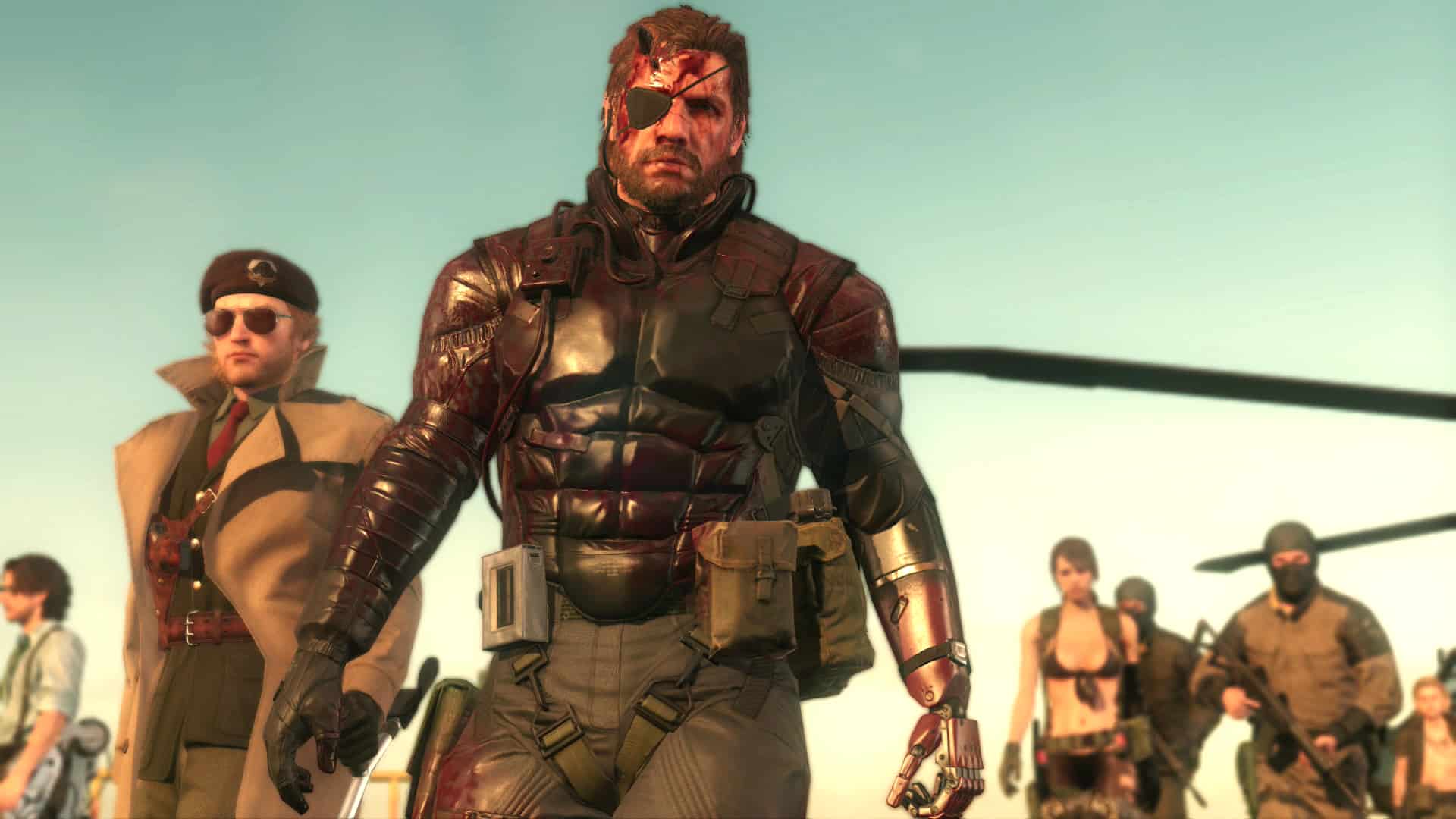For many, the Metal Gear series is the masterpiece of Hideo Kojima, and the franchise that defined how stealth worked across the entire medium. The series has been published by Konami ever since its inception, and for the most part, developed by it too. Other studios have had a few attempts, with some spinoffs being produced along the way.
With almost four decades of history, Metal Gear is one of gaming’s most recognizable names. Here’s that history, from past to present.
Metal Gear (1987)
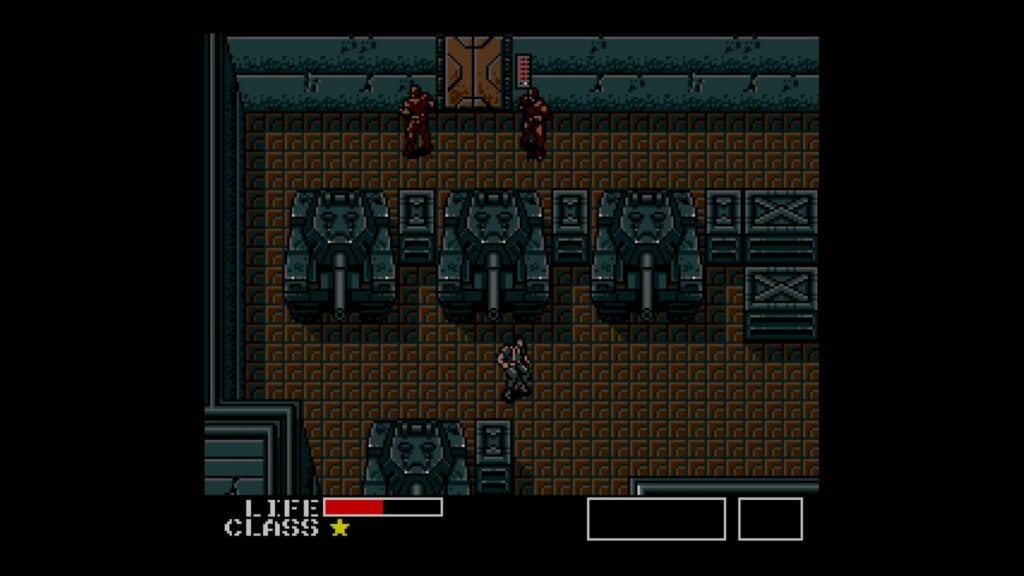
One of the first ever games directed by legendary developer Hideo Kojima, Metal Gear is often credited as the title that popularized stealth action games. You control Solid Snake, a military operative on a solo mission to infiltrate a base called Outer Heaven. This base has a weapon of mass destruction called a Metal Gear, and you must find it and destroy it.
The stealth mechanics established in Metal Gear are used in the rest of the franchise. Your main objective is to avoid being seen by enemies by watching their movement patterns. If you’re seen, the game enters Alert Mode, of which there are two phases. In the first, a single exclamation mark appears over the enemy. Here, you just have to move out of their field of view to fully avoid detection. Instead, there’s the possibility that two exclamation marks appear instead. This is where mayhem breaks out, and the only way out is by entering an elevator, or killing all enemies in sight.
While traversing Outer Heaven, there are three different buildings to explore. Each of these have different floors, accessed using keycards that you find on enemies. Along the way, you’ll encounter hostages, you you can save for a boost to your health and carrying capacity. This allows you to take more powerful weapons from your enemies. There’s also a mechanic where you can use a transceiver to talk to several of your allies outside of the base. They can offer advice on how to handle certain situations. However, if you don’t keep track of their frequency number, you’ll be locked out of contacting them, so pay attention!
There’s no doubt that Metal Gear is dated by modern standards, but it’s amazing how many of the mechanics remain in the series today.
Snake’s Revenge (1990)
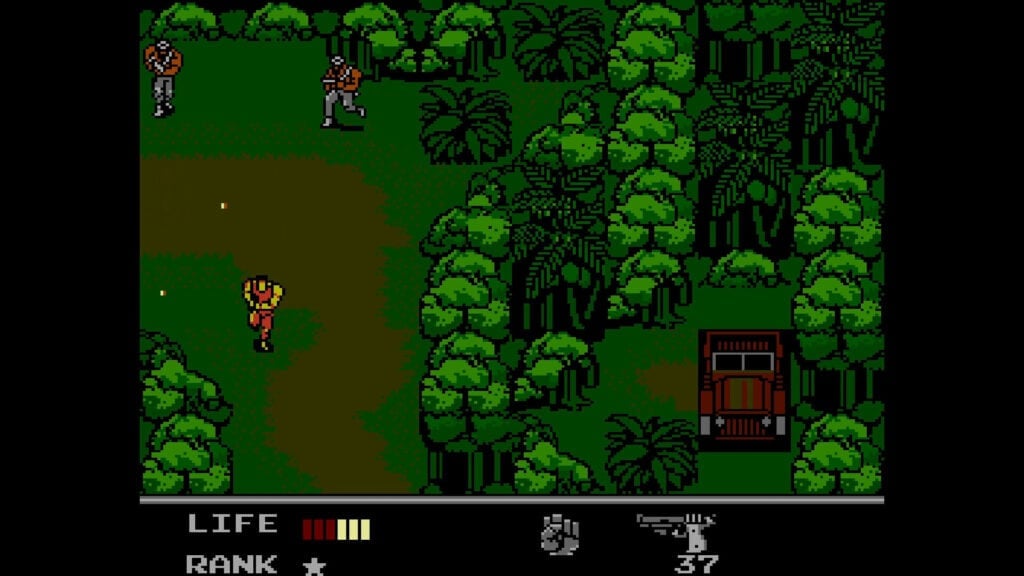
Snake’s Revenge is a sequel to the original game released for the NES. The story here is very much more of the same. A Middle Eastern nation is discovered to have plans for a new Metal Gear and is in the process of building it. Under the mission codename Operation 747, Solid Snake infiltrates a jungle base alongside agents John Turner and Nick Myer. While some of the details in the middle change a little, Snake’s Revenge‘s story is large the same as the original.
Hideo Kojima wasn’t involved with Snake’s Revenge, which would explain some of the confusing decisions made for its gameplay. Stealth returns as it is in the original game, but it’s weaved with some side-scrolling sections alongside the traditional top-down view. The side-scrolling areas are, put simply, terrible. It doesn’t compliment the stealth mechanics at all. Ultimately, it just feels extremely clunky compared to the top-down areas which had already been perfected three years prior.
Nowadays, you won’t find too many fans of Snake’s Revenge. It’s generally considered to be one of the worst games in the franchise’s history, and doesn’t particularly justify its existence.
Metal Gear 2: Solid Snake (1990)
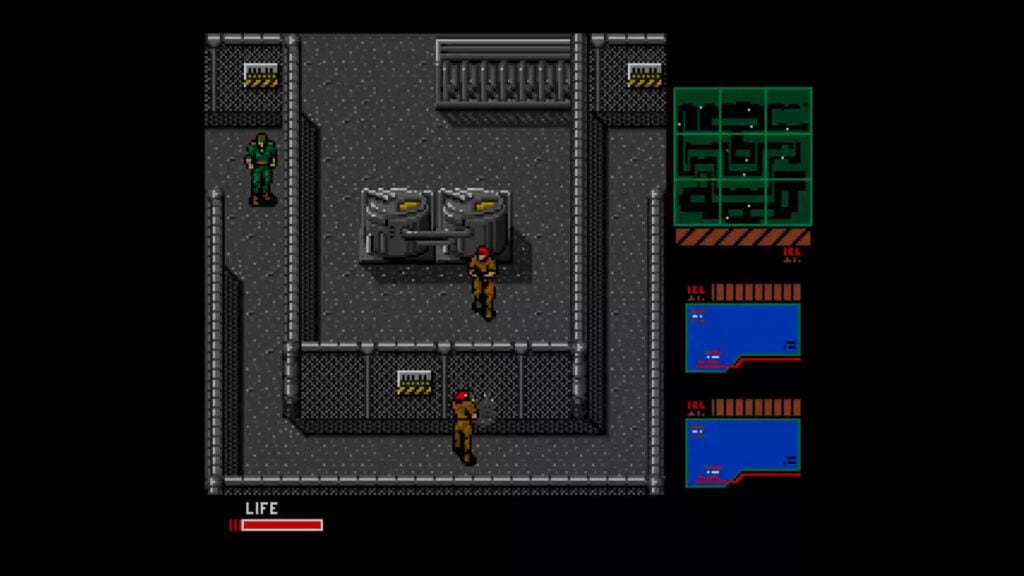
The original Metal Gear actually had two sequels. While Snake’s Revenge was developed for the NES, Metal Gear 2: Solid Snake was released for the MSX2. This title was directed by Hideo Kojima, and as a result, feels a lot more like a true sequel than Snake’s Revenge.
The story this time is much deeper, and involves you taking on the role of Solid Snake once again. His infiltration skills take him to Zanzibar Land, where he is tasked with rescuing kidnapped scientist Dr. Kio Marv. Snake learns a plot to develop a brand-new Metal Gear weapon. This leaves him in a similar position, where his ability to destroy the device could decide the fate of the world.
Metal Gear 2: Solid Snake takes the gameplay mechanics of the original, and iterates on them in smart ways. You only have to look at Snake’s Revenge to see how it can go wrong. For example, the game adds the Soliton Radar, which gives you a view of the area layout, as well as enemy locations. This allows you to plan out your moves further in advance, adding another layer of strategy to the game. It also introduces environment interaction. You can crawl under objects to avoid detection and hide inside air ducts.
Metal Gear 2: Solid Snake is one of the best 8-bit games ever made. Its influence on the series is clear to this day, even if further improvements have been made to the formula.
Metal Gear Solid (1998)
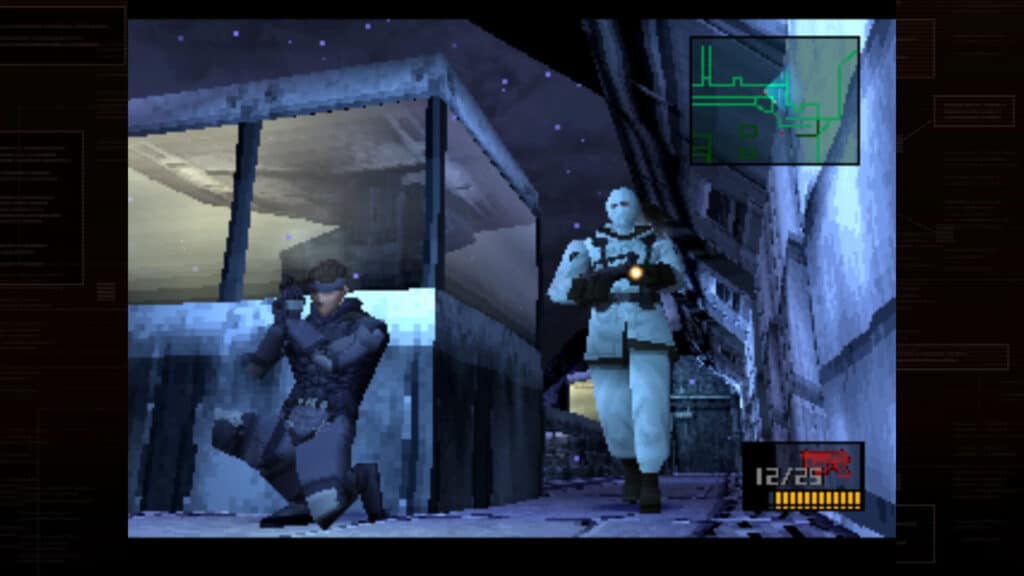
For most players, Metal Gear Solid is where their journey with the series began. While the game is a direct sequel to Metal Gear and Metal Gear 2: Solid Snake, it follows an extremely similar story. Solid Snake makes his return, as he breaks into a nuclear facility in order to stop the terrorist threat of FOXHOUND, which is threatening nuclear war.
For the first time, Metal Gear Solid introduces 3D graphics to the series, used to render gameplay and cinematic cutscenes with full voice acting to boot. Despite the move, the core gameplay remains the same as the games prior, with Snake moving through top-down environments as stealthily as possible. There are plenty of tools at his disposal, including the now-iconic cardboard box disguise.
All in all, Metal Gear Solid is a triumph. Its sequels may have gone on to trump its achievements, but for what it started, it easily achieves legendary status.
Metal Gear Solid 2: Sons of Liberty (2001)
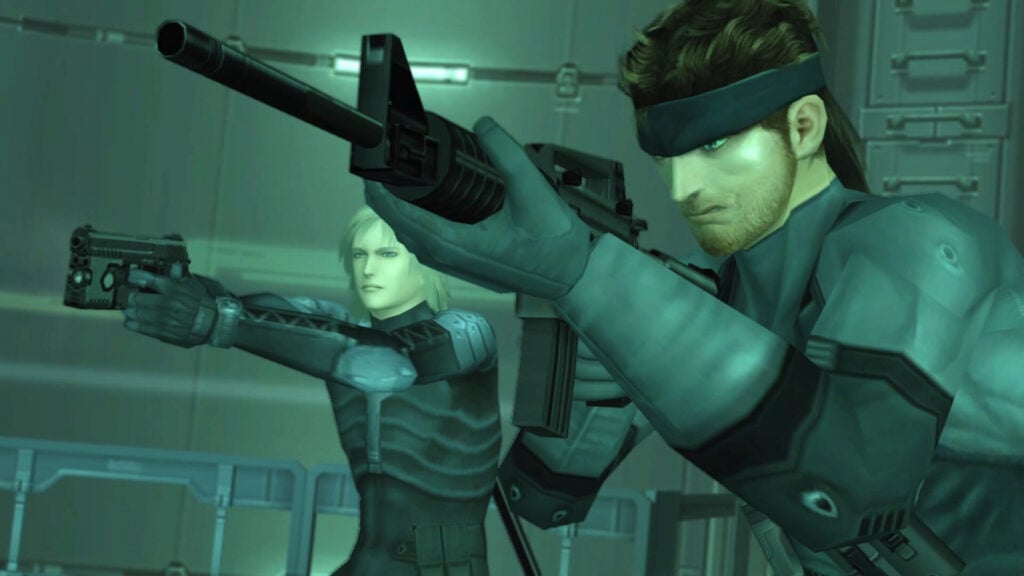
We’re going to come out of the gate with a bold statement. Metal Gear Solid 2: Sons of Liberty is one of the greatest video games of all time. Released three years after its predecessor, the game became one of the first examples of how the medium could be used as a tool for storytelling and social criticism.
The story itself follows Snake, as he attempts to stop a mysterious group called the Sons of Liberty. After kidnapping the President of the United States, the group threatens to create an environmental disaster that threatens all life on Earth. The story inculdes themes of political conspiracy and postmodernism, while dealing with topics like post-truth politics long before they became relevant in the mainstream. It’s actually impressive just how much it deals with, despite topically being similar to previous releases.
In Metal Gear Solid 2: Sons of Liberty, you have access to both Snake and Raiden as playable characters. This changes the game in many different situations, meaning you’ve got to change up your approach throughout. First-person aiming is introduced, as is hanging from ledges to hide from enemies. The environment is more interactive than ever, and you can use pretty much everything to your advantage. If there were any problems with the original Metal Gear Solid, Sons of Liberty takes care to fix it where possible.
Considering how well-regarded the original game was, it almost seemed impossible to live up to the expectations. Metal Gear Solid 2: Snakes of Liberty lives up to them, and then some.
Metal Gear Solid: The Twin Snakes (2004)
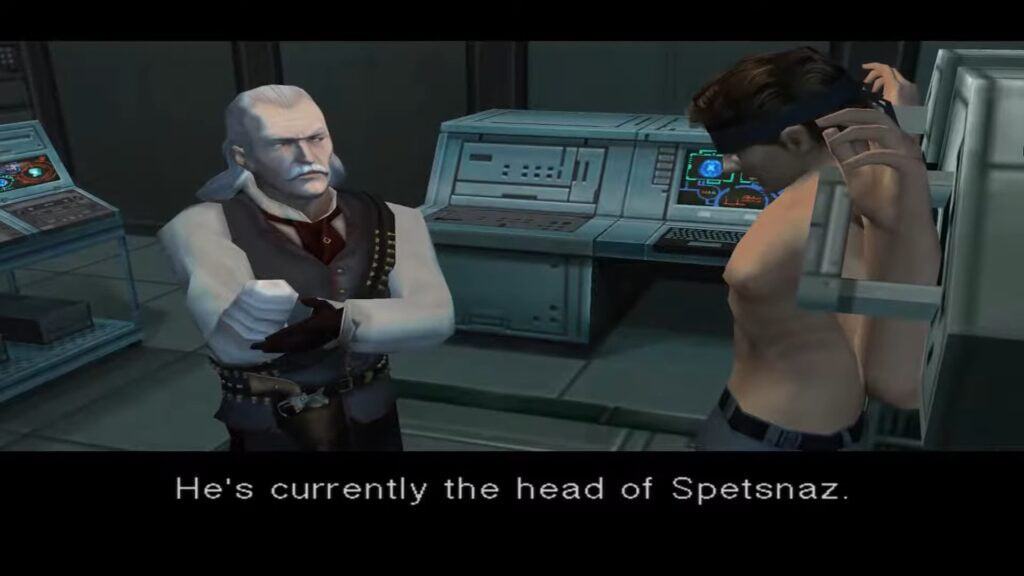
©Screenshot from Metal Gear Solid: The Twin Snakes.
Released exclusively for the Nintendo GameCube, Metal Gear Solid: The Twin Snakes is a full remake of the original Metal Gear Solid. The story is left pretty much exactly the same, with a few new cutscenes added for some extra context. Many of the old cutscenes have been re-directed, giving them a more cinematic feel.
The remake plays it safe in the gameplay department. Ultimately, the original title already got it right, so a massive overhaul was deemed unnecessary. That said, it does add some features first introduced in Metal Gear Solid 2: Sons of Liberty to modernize the experience. The first-person view makes a return, giving you more precise aim. As does the ability to hang, offering more opportunities for stealth. AI in Metal Gear Solid: Twin Snakes comes closer to what you’d expect to find from Sons of Liberty too. They’re smarter and work together to hunt you down.
Overall, the game is a pretty solid remake of an amazing game. If you’re choosing one to play through for the first time, it’s honestly a total 50/50 coin toss. Some will prefer the untouched vision of the original, while others will want the updated mechanics. Both are valid ways to experience Metal Gear Solid.
Metal Gear Solid 3: Snake Eater (2004)
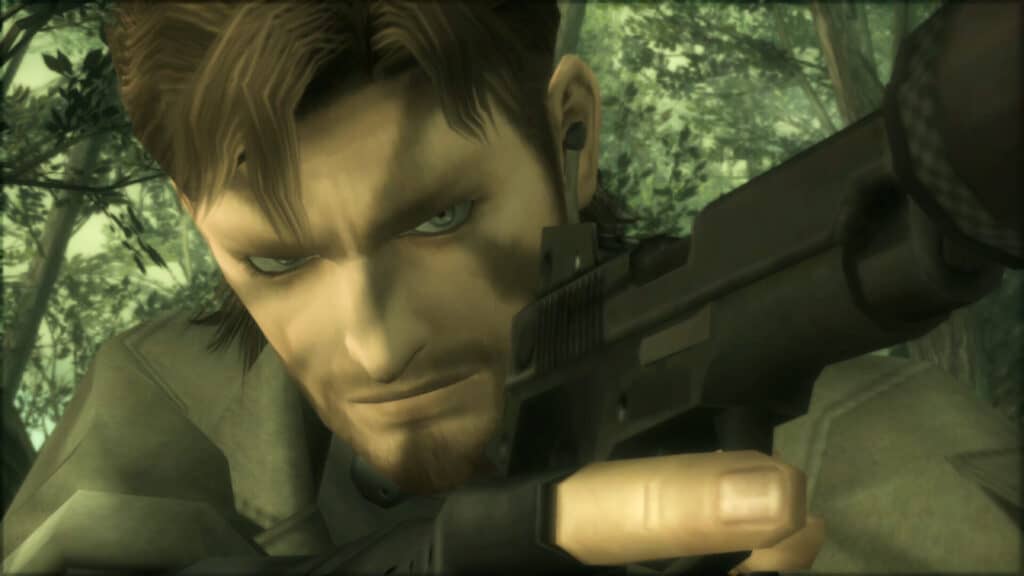
Metal Gear Solid 3: Snake Eater was released three years after its predecessor, with Kojima and his team taking the time to get it right. And boy, did they!
This time set in the 1960s, Metal Gear Solid 3: Snake Eater sees you take Snake on a journey deep into the Soviet Union to rescue a scientist known as Sokolov, while looking to sabotage a nuclear weapon of mass destruction. Compared to the heavy-hitting themes of Sons of Liberty, it almost seems tame.
The biggest change comes by way of the environment. The greys of previous games have been replaced by the greens of the forest. Most of the game takes place outdoors in a Soviet Union forest. The game introduces an advanced camouflage system that gives you more ways than ever to blend in with the environment. This is gauged by a camouflage index, a number between 1 and 100 that determines how visible you are to enemies.
Melee combat is overhauled, with a new close-quarters combat system offering plenty of ways to engage the enemies. On top of this, the basic life bar is gone, replaced by injuries all over Snake’s body. If you get hit in the leg, you have to heal that area specifically, or the game makes it very tough to recover over time.
It’s very good. Great, even. The strategy of Konami, to slowly innovate over time with the series and leave the experiments to the spinoffs, is a winning one.
Metal Gear Acid (2004)
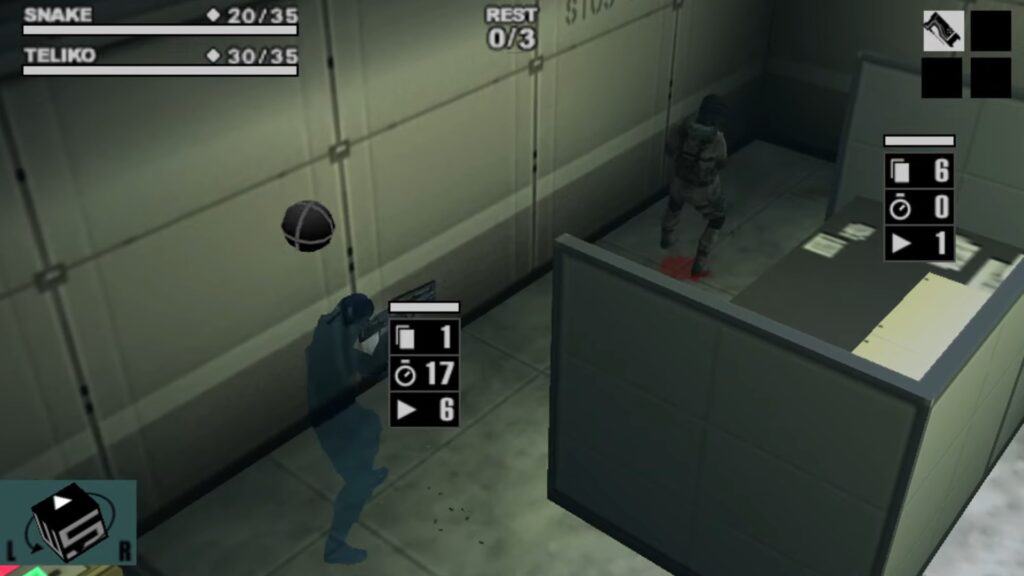
©Screenshot from Metal Gear Acid.
Metal Gear Acid saw the series take a turn-based approach, switching up the genre for its PlayStation Portable debut. Story-wise, the title sees Solid Snake return, as he attempts to rescue a US senator who has been kidnapped by a group of terrorists. It’s not the most complex of stories for the series, for sure.
What sets Metal Gear Acid apart is its turn-based combat. Before each mission, you build a deck of cards, with action, weapon, item, and movement cards to choose from. Then, during combat, you deploy them to defeat your enemies. Stealth is still important, but when push comes to shove, this is how you fight in this game. Strategy has always been crucial to Metal Gear, but with the added complexity of deck-building, it goes up a level.
Reception to the game was mixed, but there’s definitely room for more experimental games in the series. It won’t be everyone’s favorite, but Metal Gear Acid earns its place in the series lineup.
Metal Gear Acid 2 (2005)
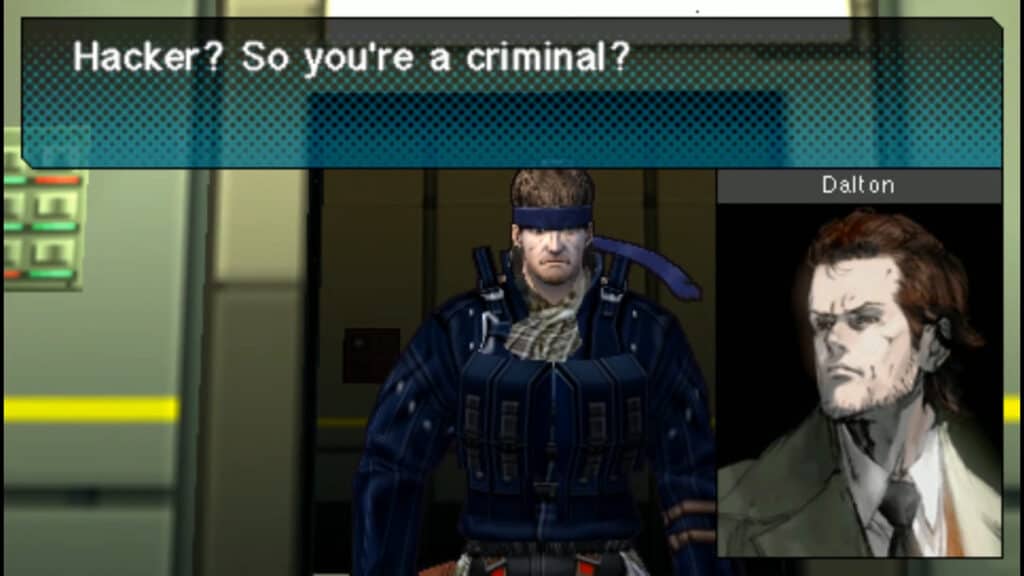
©Screenshot from Metal Gear Acid 2.
Released just a year after the original, Metal Gear Acid 2 continued the series’ PlayStation Portable adventures.
This time around, the story focuses on Snake’s infiltration of the company SaintLogic and its research facilities. Like Metal Gear Acid, it’s a scaled-down story to what players have come to expect from the series.
The gameplay here is similar to the original too. The deck-building and turn-based combat returns, without much innovation to the formula. However, you can now control multiple characters in the same battle, adding another layer of strategy to the experience. With a total of 565 cards now added, you have access to more than double than in the original game.
Overall, Metal Gear Acid 2 is the experimental formula of the first game, refined and strengthened. If turn-based games aren’t for you, then it probably won’t win you over, but it’s great for what it is.
Metal Gear Solid: Portable Ops (2006)
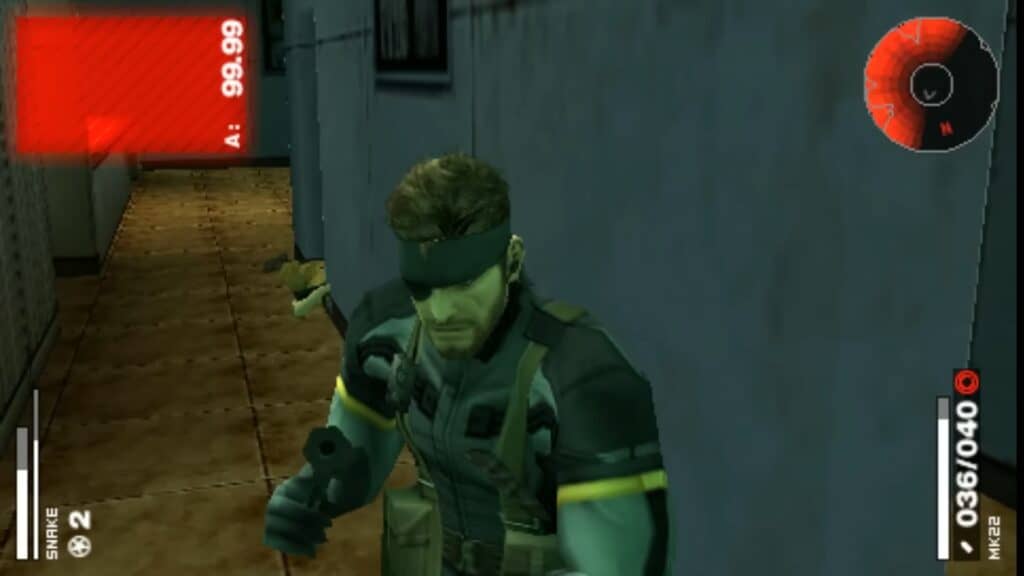
©Screenshot from Metal Gear Solid: Portable Ops.
Metal Gear Solid: Portable Ops was not the first game in the series to come to PlayStation Portable, but it was the first to attempt to adapt the general formula of the series for the platform, making as few concessions as possible.
The plot of Metal Gear Solid: Portable Ops is just vintage Metal Gear. Snake finds himself on a mission to uncover a new Metal Gear weapon of mass destruction, this time coming from a former unit of his, FOX. Don’t expect this game to reinvent the wheel.
Metal Gear Solid: Portable Ops makes one huge gameplay innovation. Rather than a solo approach, in each mission, you take a squad of four along for the ride. These four units come with their own strengths and weaknesses, so you’ve got to make sure you’ve got a balanced squad to have the best chance of success. You’ll only control one at a time, and you can switch them out at will. The game offers various ways for you to recruit enemy soldiers. This means that going gung-ho with killing them isn’t always the best way forward. They could be more useful to you alive than dead.
Beyond that one feature, the game offers a fair standard Metal Gear experience. Fans of the franchise certainly won’t be shocked by anything in the game, for better or for worse.
Metal Gear Solid Mobile (2008)
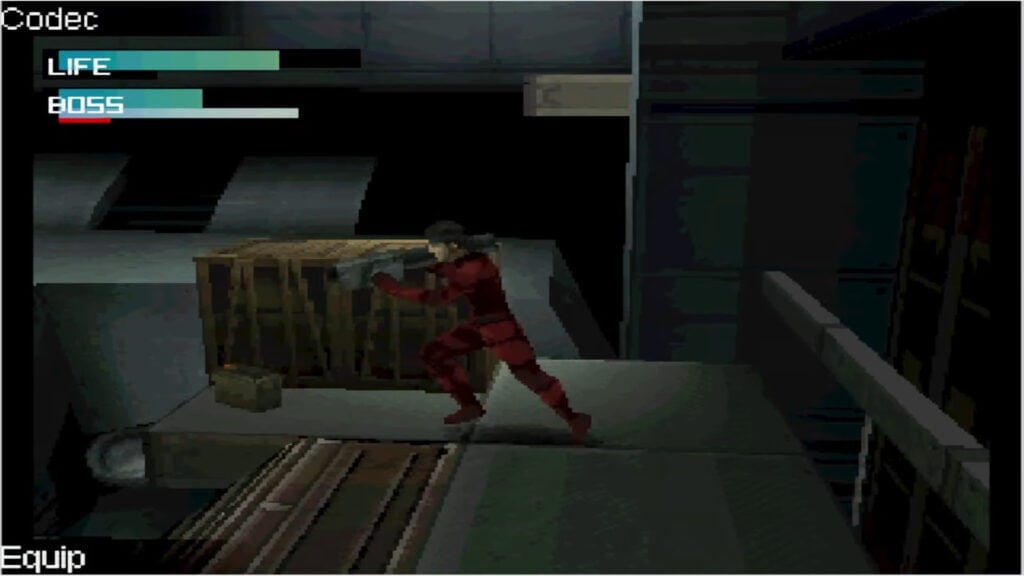
©Screenshot from Metal Gear Solid Mobile.
Metal Gear Solid Mobile was released as a way to capture the spirit of the series on mobile devices. The story is extremely similar to the original Metal Gear Solid, with Solid Snake looking to infiltrate an enemy base to destroy a weapon called the Metal Gear REX. That said, there are a few twists in the tale that justify this game’s existence.
In terms of gameplay, the game tries to keep things as simple as possible. The stealth action mechanics are all there, but the mobile limitations mean they don’t always work smoothly. Levels are scaled down from what most would expect, too. Overall though, it’s recognizable as a Metal Gear Solid game. It’s just a shame the limitations on the gameplay weigh down so heavily on the experience.
It’s great that Metal Gear Solid Mobile offers its own story for hardcore fans of the franchise to enjoy. But its dated gameplay means most people would get more enjoyment from this game by just reading a synopsis.
Metal Gear Solid 4: Guns of the Patriots (2008)
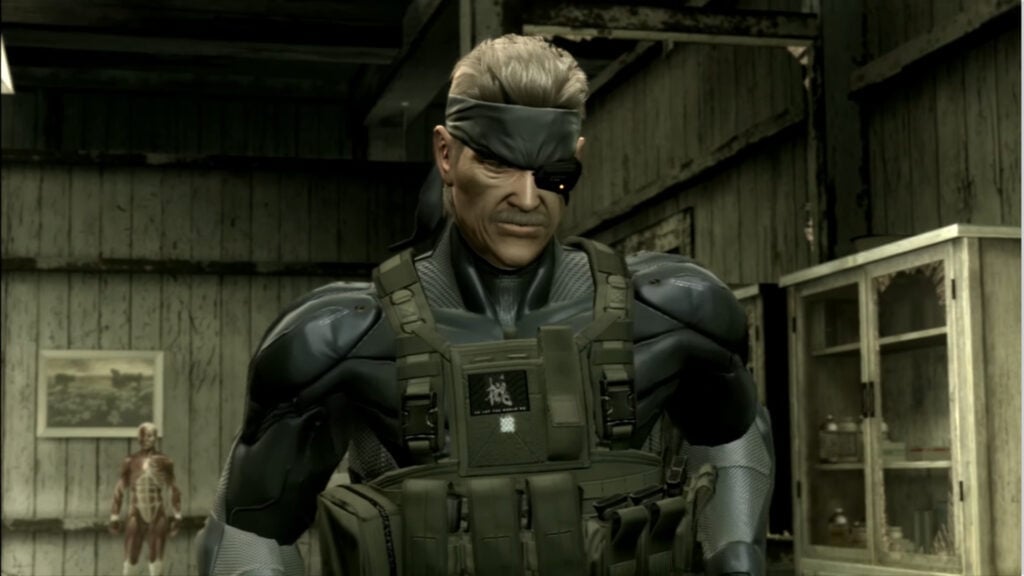
©Screenshot from Metal Gear Solid 4: Guns of the Patriots.
As the fourth mainline game in the Metal Gear Solid series, Guns of the Patriots is ambitious and impressive in equal measure. Chronologically, it’s the final game of the franchise, following Snake on his final mission to stop Liquid Ocelot, who is looking to control the world with his Sons of the Patriots AI system.
At times, Metal Gear Solid 4: Guns of the Patriots tries too hard with certain gameplay elements. Everything we love about the series is still here, and the addition of modernized third-person controls is a welcome change. But the Psyche Meter, which sees Snake get stressed during combat due to a number of factors, is too much of a hindrance in our eyes. It’s just too binary in how it functions. Snake can lose psyche due to killing too many enemies, and then read an adult magazine to make it all better. That said, it’s not a total game-killer.
Innovations from the series’ past return better than ever. For example, camouflage is replaced by OctoCamo, so you can blend in any environment. There’s a lot to love here, even if visually it falls victim to the late 2000’s love of grey/brown color palettes. Its PlayStation 3 exclusivity makes it hard to get hold of nowadays, but if you can, definitely give it a shot.
Metal Gear Online (2008)
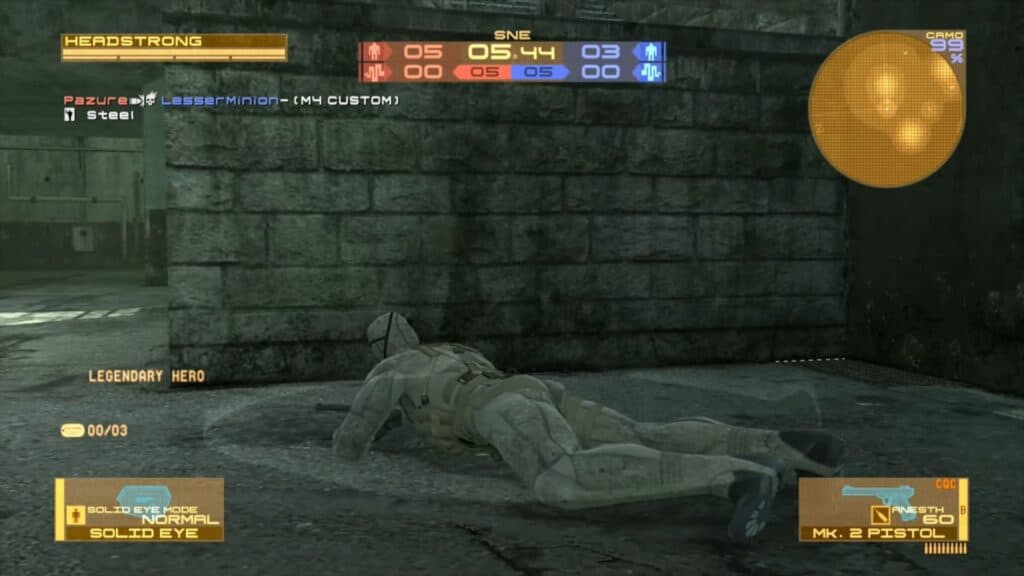
©Screenshot from Metal Gear Online.
Released as the multiplayer component to Metal Gear Solid 4: Guns of the Patriots, Metal Gear Online allows players to use many of the single-player mechanics to partake in tactical shooter gameplay against other players. Due to the nature of multiplayer gaming, it’s harder for stealth to take center stage here, but the game does its best to encourage covert gameplay.
In-game, you choose from a few different classes, which affect the way you play, including the Soldier, Scout, and Medic. These have their own unique abilities that you can deploy during combat, with most being used to help the team. Scouts for example have the ability to mark spotted enemies, making them easier to see. You can customize your classes further, with different outfits and equipment available to make them more personalized.
The game was eventually shut down, and replaced by a title of the same name released as the multiplayer component of Metal Gear Solid V: The Phantom Pain. However, there are still private servers of the original Metal Gear Online being emulated on PC. If you’ve got the tech know-how, there are ways to jump in and play this version to this day.
Metal Gear Solid Touch (2009)
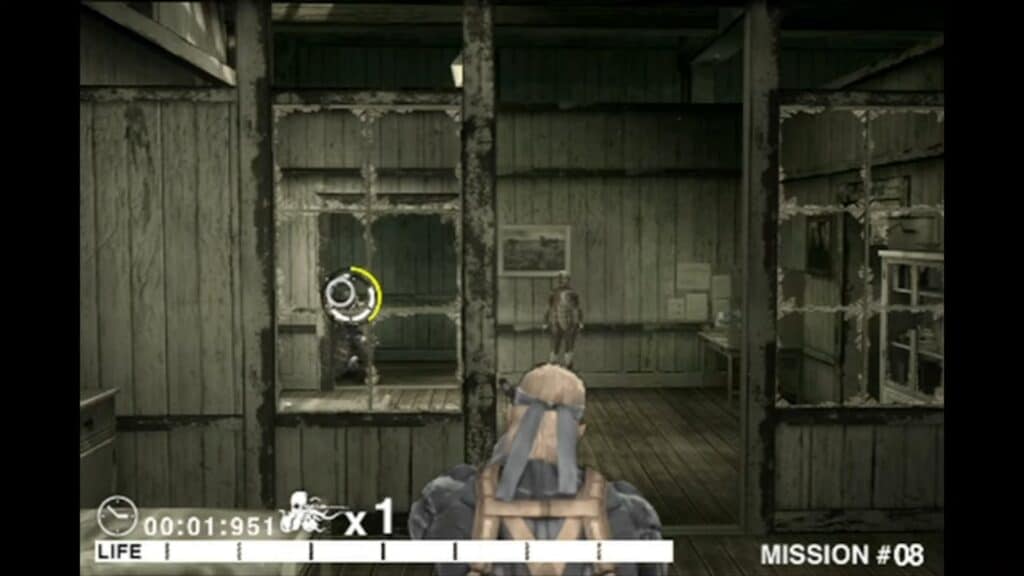
©Screenshot from Metal Gear Solid Touch.
Let’s get one thing out of the way – Metal Gear Solid Touch is rough. Released exclusively on iOS back in 2009, the game was a companion to Metal Gear Solid 4: Guns of the Patriots. It even retells the game’s story in a series of tap-to-shoot missions. In every level, the aim is to tap on enemies to shoot them. Even by early iOS game standards, it’s nothing to write home about.
It’s hard to say who this is really for. Those who had a PlayStation 3 would have just played Metal Gear Solid 4: Guns of the Patriots. Those who didn’t wouldn’t be particularly driven to pick one up after playing this.
Metal Gear Solid Touch was removed from the App Store in 2012. If you want to play it nowadays, you have to jump through some serious hoops. So much so that it couldn’t possibly be worth the effort given it’s plain bad. There’s plenty of footage of the game on YouTube – if you want to see what Metal Gear Solid Touch entails, just watch a playthrough.
Metal Gear Solid: Peace Walker (2010)
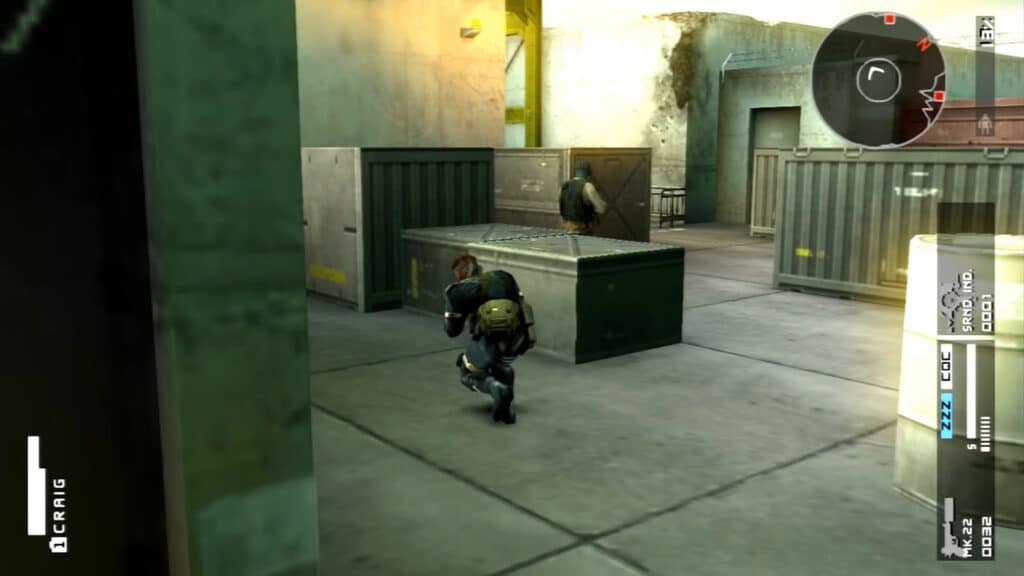
©Screenshot from Metal Gear Solid: Peace Walker.
Despite being released exclusively on the PlayStation Portable, Metal Gear Solid: Peace Walker is considered to be one of the strongest iterations of the franchise. It manages to overcome its portable limitations, offering a unique story and a series of strong gameplay decisions.
The story of Metal Gear Solid: Peace Walker begins in 1974, following Snake as he attempts to establish his own private military company, Militaires Sans Frontières. Throughout the game, you complete a series of missions as he looks to maintain some level of peace in the world. Meanwhile, a weapon known as the Peace Walker is in development, threatening this peace and making Snake’s job much more difficult.
There are two main game modes in Metal Gear Solid: Peace Walker: Mission and Mother Base. Mission is where the actual stealth and action gameplay happens, and are separated into two types. The first is Main Ops, which tells the actual story of the game. Then, there’s Extra Ops, which have more specific objectives and are optional. Mother Base mode is an in-depth base management feature, where you can recruit soldiers and give them various roles. This improves the strength of the Mother Base, which comes in handy during certain missions in the game. You can even recruit enemy soldiers from the battlefield through the Fulton Recovery System, extracting them to the Mother Base for your own benefit.
Beyond this, Metal Gear Solid: Peace Walker does a great job of translating the basic mechanics of the series to the PSP. Even to this day, it remains a worthwhile playthrough for hardcore fans of the franchise.
Metal Gear Rising: Revengeance (2013)
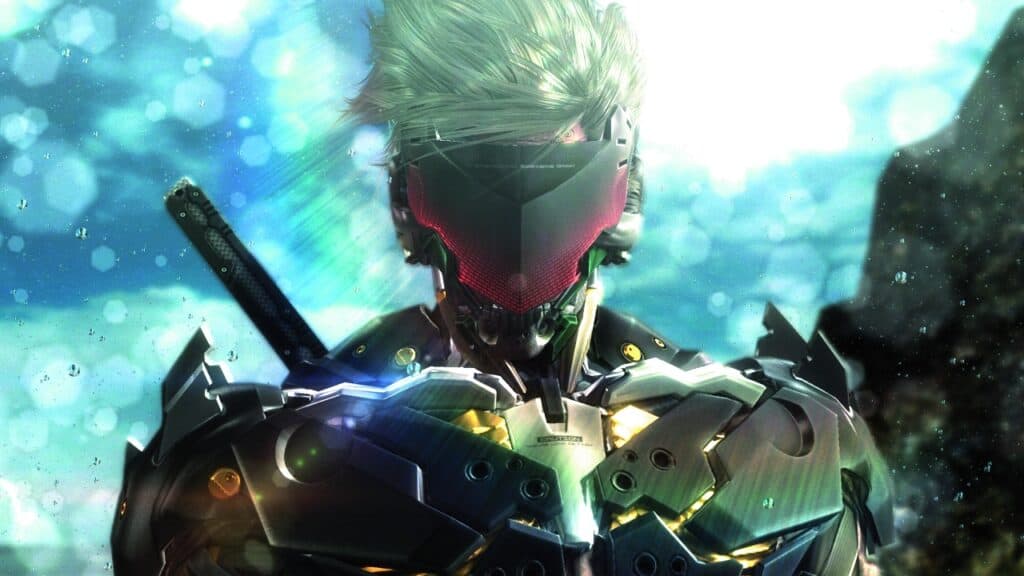
Of all the games in the series so far, Metal Gear Rising: Revengeance is the biggest-ever departure from the formula. Stealth goes out of the window here, in favor of fast-paced melee action.
Despite the change of pace and its own distinct visual style, the game does take place in the same timeline as the main Metal Gear games. This story focuses on Raiden, who operates as a member of a private military company involved in a struggle with a company named Desperado Enforcement, which plans to profit from the creation of a worldwide war. Raiden’s journey takes him around the world, as he seeks to put a stop to the evil plan of Desperado Enforcement.
The gameplay of Metal Gear Rising: Revengeance is arguably the most intense of the entire series. You’ll get up close and personal with enemies, facing them face-to-face with a precise and fluid melee combat system. The game features a Blade Mode, where you can slow time to target specific areas of enemies. This has utility out of combat too, with the feature used in several puzzles throughout the game.
Metal Gear Rising: Revengeance‘s new genre allows boss battles to become a priority. Here, they’re challenging and rewarding in equal measure, evoking the boss battles in other classic hack-and-slash titles. You’ll have to use strategy and precision to overcome these battles.
There’s no doubt that Metal Gear Rising: Revengeance was a strange change in direction for the franchise. However, it feels fresh, and was executed extremely well, so why not?
Metal Gear Solid V: Ground Zeroes (2014)
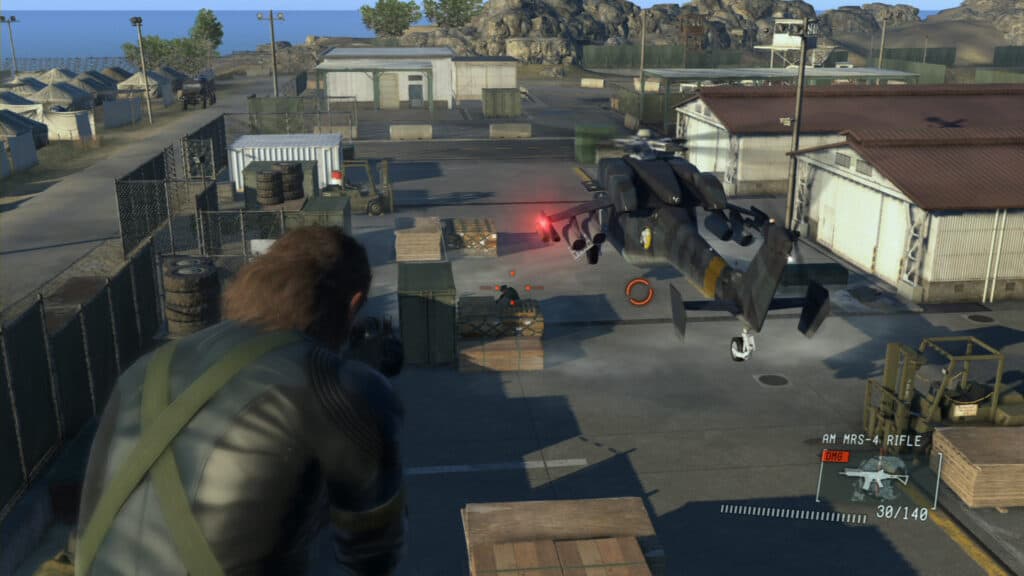
Released as a prologue to The Phantom Pain, Metal Gear Solid V: Ground Zeroes gave players a hint at what they could expect from the next release. The story is as simple as it gets here. Snake is infiltrating Camp Omega as he looks to rescue his allies from the detention facility. Along the way, he uncovers a huge conspiracy involving an organization named Cipher. This leads into the story of the next game perfectly, with this serving as a teaser.
It also introduces a few new mechanics. Camp Omega is a great example of a small open world, which comprises much of the next release, The Phantom Pain. Metal Gear Solid V: Ground Zeroes also added dynamic weather, which changed with the passage of time. This affects how the AI interacted with you, too. For example, they’re going to have a harder time spotting you during a rainy night, than in the middle of the day with clear skies. Stealth is no longer binary either. Once you’re spotted, you go into Reflex Mode, a brief moment of slow-motion that allows you to take the enemy down before their allies are alerted.
Fans of the series should still play Metal Gear Solid V: Ground Zeroes as a narrative experience, but everything the game offers is definitely improved in The Phantom Pain.
Metal Gear Solid V: The Phantom Pain (2015)
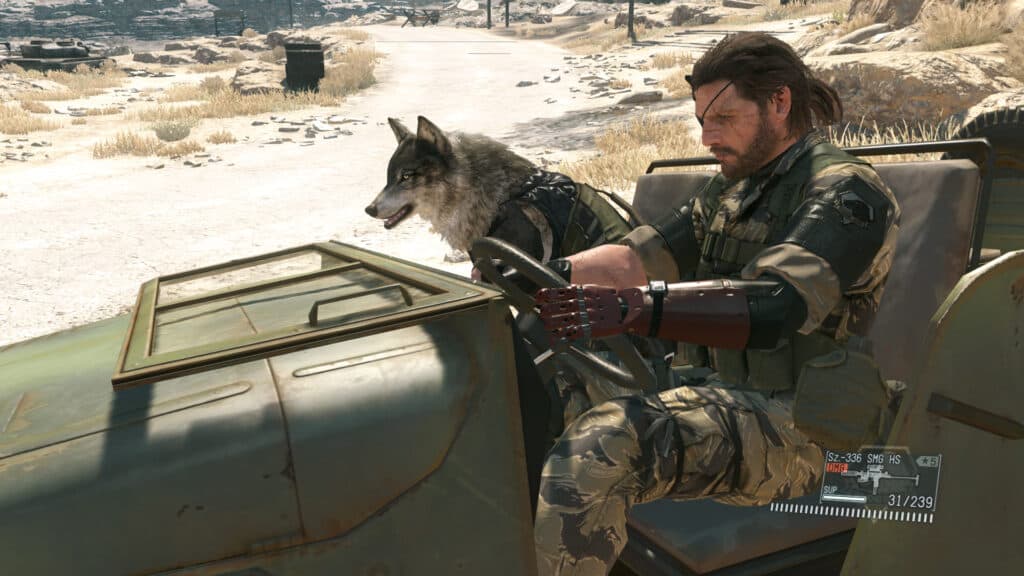
Metal Gear Solid V: The Phantom Pain is a marvel. Released just a year on from Ground Zeroes, the game impressed with its deep story and incredible graphics. The fact that this game found its way onto the Xbox 360 and PlayStation 3 is nothing short of technical wizardry.
The conspiracy uncovered by Snake involving Cipher in Ground Zeroes continues to play a key role here. Snake’s worldwide journey to hunt down the organization sees him rebuild his mercenary group called the Diamond Dogs, while he slowly transforms into the iconic character, Big Boss.
The gameplay mechanics in the game didn’t come as a surprise to those who played Ground Zeroes a year prior. Stealth remains the focus, this time taking place in an open world with more ways to hide than ever. Where it does innovate is in the Mother Base system, which first appeared in previous games. As you build up the Diamond Dogs, you add new soldiers to your lineup, while researching brand-new weapons to use in combat. Managing the people of Mother Base takes up a surprising amount of time, but the game does a great job of keeping it engaging by making it feel like you’re really progressing throughout.
Considering it’s almost a decade old now, Metal Gear Solid V: The Phantom Pain remains a remarkable achievement. It still feels as though it could have been released today, and as the final Kojima game in the series, will go down in history for all the right reasons.
Metal Gear Survive (2018)
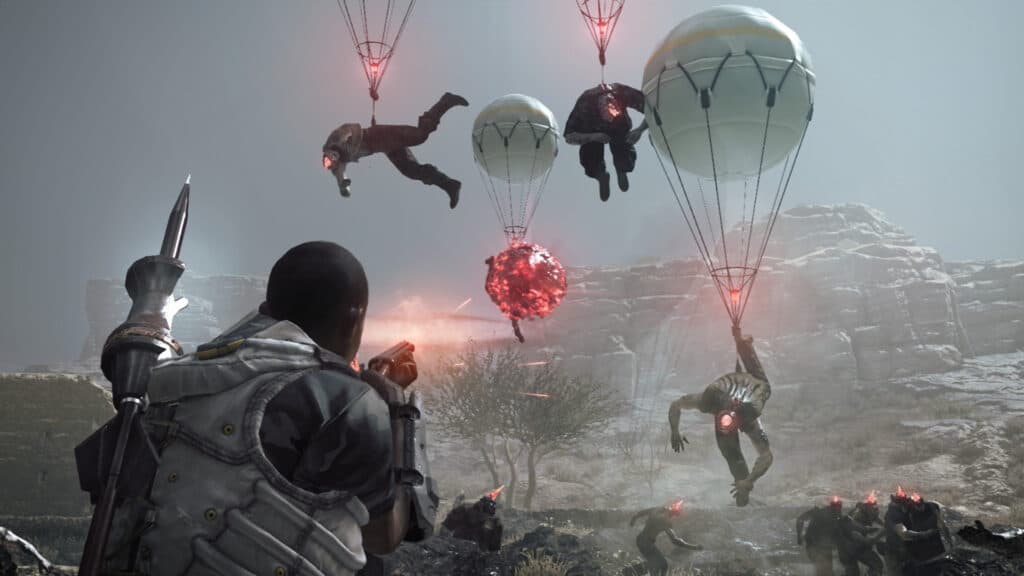
As the first Metal Gear game produced since Hideo Kojima left Konami in 2015, Metal Gear Survive had a lot to live up to. For reasons that we’ll get into, it didn’t go down too well.
We’ll start with the story. You’re transported into another dimension called Dite, a dangerous world filled with Wanderers (for all intents and purposes, these are zombies). As a soldier of a group named Wardenclyffe Section, you’ve got to figure out how to survive in the new world while discovering its mysteries through the story missions. If that doesn’t sound like a Metal Gear game, don’t worry. It doesn’t feel like one, either.
First of all, it’s a survival game, with some elements of tower defense. The stealth the series is known for is there, but isn’t a focus. Gathering supplies for survival such as food and water is essential, and you can also craft new items from whatever you find around the world. Then, the game encourages you to build a base. You can customize this in different ways, installing structures and traps to ensure you’re as safe as possible. Rescued survivors around the world can be sent to your base, making it feel like a real community. It’s all standard survival fare, and feels a lot more DayZ than Metal Gear.
The game does offer a four-player co-op mode, which makes the world feel a lot less lonely. Still most would consider it a worrying first step in the post-Kojima Metal Gear series.
The image featured at the top of this post is ©Konami.
